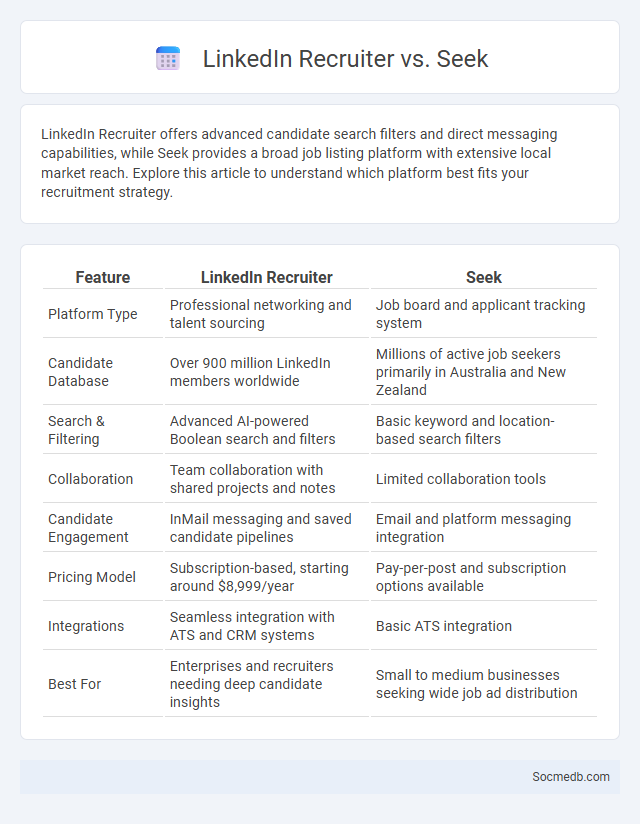
Photo illustration: LinkedIn Recruiter vs Seek
LinkedIn Recruiter offers advanced candidate search filters and direct messaging capabilities, while Seek provides a broad job listing platform with extensive local market reach. Explore this article to understand which platform best fits your recruitment strategy.
Table of Comparison
| Feature | LinkedIn Recruiter | Seek |
|---|---|---|
| Platform Type | Professional networking and talent sourcing | Job board and applicant tracking system |
| Candidate Database | Over 900 million LinkedIn members worldwide | Millions of active job seekers primarily in Australia and New Zealand |
| Search & Filtering | Advanced AI-powered Boolean search and filters | Basic keyword and location-based search filters |
| Collaboration | Team collaboration with shared projects and notes | Limited collaboration tools |
| Candidate Engagement | InMail messaging and saved candidate pipelines | Email and platform messaging integration |
| Pricing Model | Subscription-based, starting around $8,999/year | Pay-per-post and subscription options available |
| Integrations | Seamless integration with ATS and CRM systems | Basic ATS integration |
| Best For | Enterprises and recruiters needing deep candidate insights | Small to medium businesses seeking wide job ad distribution |
Overview of LinkedIn Recruiter, Seek, and Talent Acquisition
LinkedIn Recruiter offers advanced search filters and candidate management tools that streamline your talent acquisition process, making it easier to identify top professionals across diverse industries. Seek provides a comprehensive job marketplace with robust employer branding features designed to attract qualified candidates and enhance recruitment reach. Talent acquisition platforms integrate data analytics and AI-driven insights to optimize hiring strategies, reduce time-to-fill, and improve candidate quality.
Key Features Comparison: LinkedIn Recruiter vs Seek
LinkedIn Recruiter offers advanced candidate search filters, InMail messaging, and integration with LinkedIn profiles for comprehensive talent insights, while Seek focuses on job posting simplicity and a large local job seeker database ideal for targeted recruitment. LinkedIn excels in passive candidate sourcing and professional networking, whereas Seek provides streamlined application management and cost-effective hiring solutions primarily in the Australian and New Zealand markets. Both platforms support applicant tracking but differ significantly in user experience, with LinkedIn catering to global recruitment and Seek emphasizing regional job matching efficiency.
The Role of Talent Acquisition in Modern Recruitment
Talent acquisition is crucial in modern recruitment by leveraging social media platforms such as LinkedIn, Twitter, and Instagram to identify and engage high-quality candidates efficiently. Your organization can benefit from targeted employer branding and real-time interaction with potential hires, enhancing candidate experience and streamlining the hiring process. Integrating social media analytics with talent acquisition strategies enables data-driven decisions that improve recruitment outcomes and reduce time-to-fill positions.
Pros and Cons: LinkedIn Recruiter for Hiring
LinkedIn Recruiter offers powerful tools for targeted talent acquisition by enabling access to a vast professional network of over 900 million users, advanced search filters, and personalized messaging, which streamlines the hiring process and improves candidate quality. However, hiring costs can be high due to subscription fees, and the platform may yield a surplus of unqualified applicants because of broad search results. Data privacy concerns and reliance on online profiles rather than in-depth interviews can also limit the effectiveness of hiring decisions through LinkedIn Recruiter.
Pros and Cons: Seek as a Recruitment Platform
Social media as a recruitment platform offers unparalleled access to a diverse talent pool, allowing you to target candidates with specific skills and cultural fits efficiently. However, the risks of misinformation and privacy concerns can complicate candidate vetting and compliance with hiring regulations. Balancing these factors can optimize your recruitment strategy by leveraging social insights while maintaining data integrity.
Integrating Talent Acquisition Strategies with Digital Platforms
Integrating talent acquisition strategies with digital platforms enhances your ability to attract top candidates by leveraging social media analytics and targeted advertising. Utilizing LinkedIn, Instagram, and Twitter allows you to engage passive candidates through personalized content and dynamic employer branding. This approach streamlines recruitment processes and increases the quality and diversity of your talent pool.
Cost Analysis: LinkedIn Recruiter vs Seek
LinkedIn Recruiter offers advanced candidate search filters and InMail credits starting around $8,000 annually, catering to high-volume hiring needs with a premium price point. Seek provides cost-effective job posting options with flexible pricing based on visibility and duration, suitable for small to medium-sized businesses aiming to optimize recruitment budgets. Understanding the scale and specific hiring goals helps you determine which platform delivers the best return on investment for your recruitment strategy.
User Experience and Accessibility
Optimizing social media platforms for user experience involves intuitive navigation, responsive design, and personalized content delivery to enhance engagement and satisfaction. Accessibility improvements include ensuring compatibility with screen readers, implementing adjustable text sizes, and providing alternative text for images to support users with disabilities. Prioritizing these elements fosters inclusive digital environments that accommodate diverse user needs and promote seamless interaction.
Success Metrics: Measuring Recruitment Effectiveness
Success metrics for social media recruitment include application conversion rates, cost-per-hire, and time-to-fill, providing quantifiable insights into campaign efficiency. Engagement metrics such as click-through rates, shares, and comments indicate candidate interest and brand resonance. Tracking source-of-hire data helps identify which platforms yield the highest quality candidates and improve future targeting strategies.
Choosing the Right Platform for Your Talent Acquisition Needs
Selecting the right social media platform for your talent acquisition needs hinges on understanding the demographics and user behaviors of each site. LinkedIn excels for professional networking and recruiting skilled candidates, while Instagram and TikTok attract younger, creative talent through visual and engaging content. Tailoring your strategy to your target audience's platform ensures your recruitment messages resonate and maximize reach.
 socmedb.com
socmedb.com